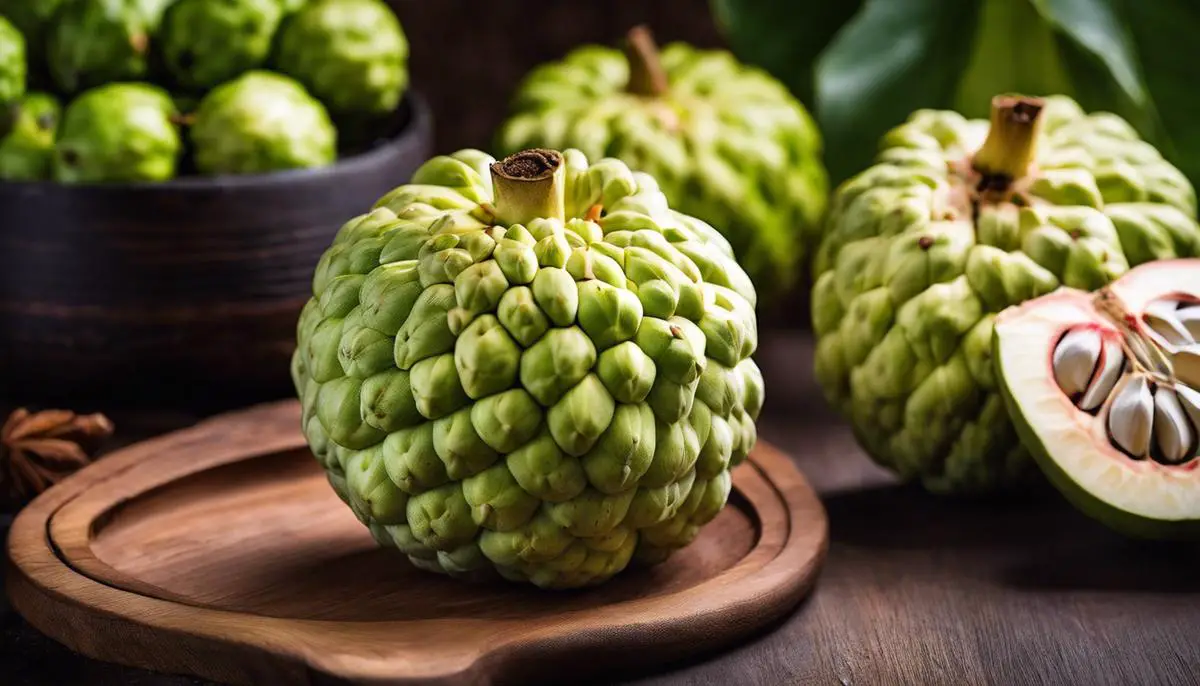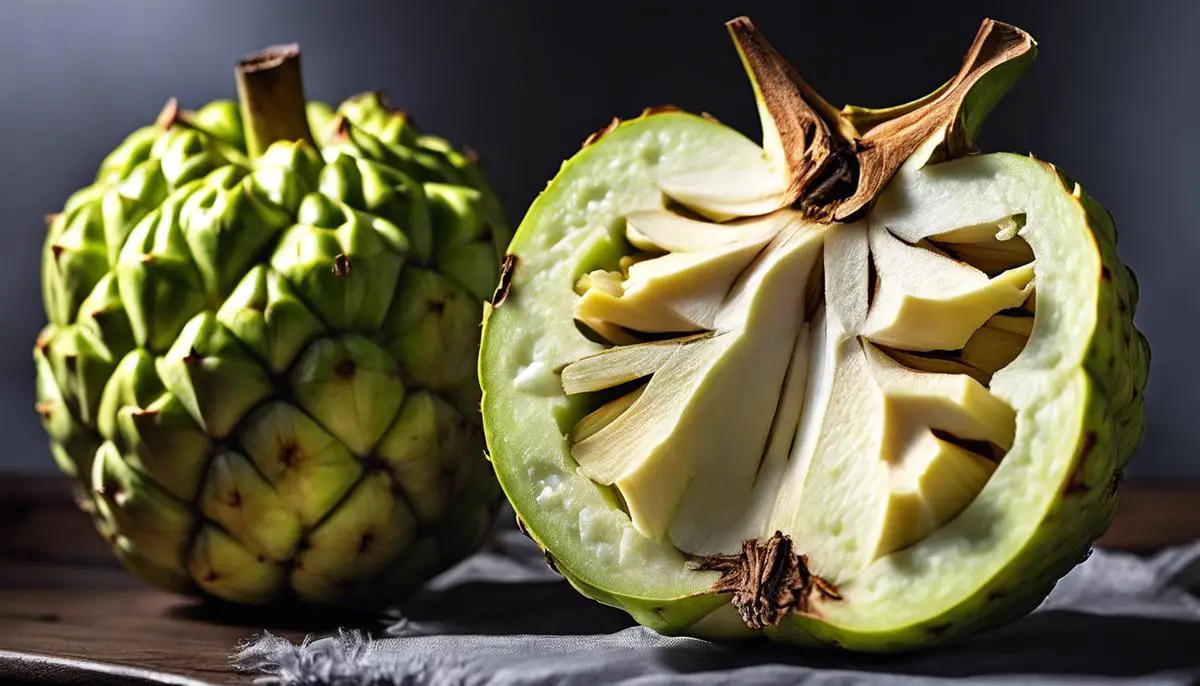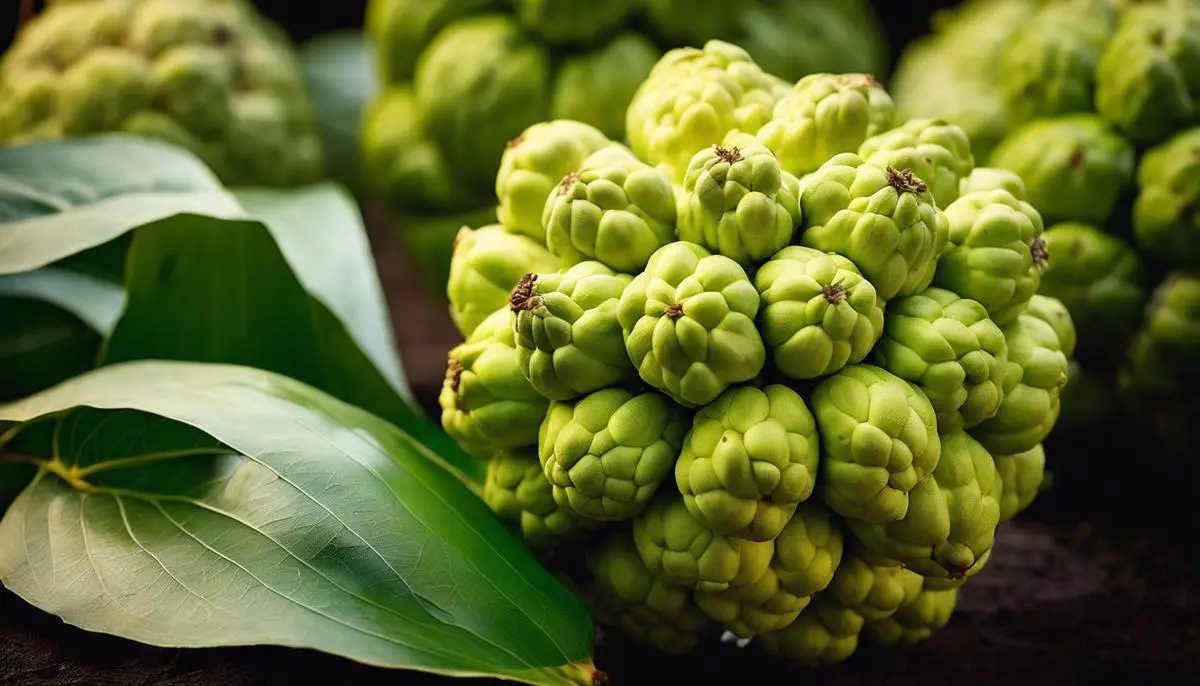Across the rich tapestry of the world’s culinary landscape, certain fruits remain largely hidden treasures – their unique flavors known only to the lucky few or the adventurous epicurean. One such marvel is the sugar apple, a tropical delight that quite literally adds a sweet twist to any culinary experience. With a history as rich as its taste, the sugar apple has carved a niche for itself, predominantly in certain tropical regions. Its many varieties add layers to its appeal, making it an intriguing subject of study for any food enthusiast. The healthful sugar apple, with its delightful taste, is not just another fruit, but an ingredient that can take your gastronomic journey to another level. Being fully acquainted with the sugar apple – knowing its origin, recognizing its ripest form, and using it in dishes – only enhances the joy of discovering this gem.
Understanding Sugar Apples
Exploring the world of fruit can sometimes feel like a treasure hunt. In each corner of the globe, and each season of the year, nature offers us a cornucopia of delectable options as diverse and exciting as the cultures and climates from whence they come. Flooded with exquisite tastes, colors, and textures, one of the most enticing fruits that fall into this category is the sugar apple.
Also known as Annona squamosa, the sugar apple is a tropical fruit originally from the West Indies and Central America that has since spread abundantly across subtropical climates, particularly Southeast Asia and South America. It’s acclaimed globally for its irresistible sweet pulp, which is the reason for its name.
A member of the Annonaceae family, this delectable offering is concocted by nature as a compact, roundish or heart-shaped fruit decorated with a lumpy skin. Typically light green or sometimes a more blushing shade, its exterior is formed from tight clusters of bulges which hold each distinctive segment separating easily once the fruit is ripe. Unveiling a creamy white flesh is the reward for breaking past its rough exterior.
The taste of sugar apple is where essence really shines. A delightful merger of robust flavors, sugar apple offers a taste reminiscent of a sweet custard with overtones of sweet pineapple, creamy banana, coconut, and a hint of vanilla. Its aroma is just as enchanting, boasting a sweet, slightly musky allure that tantalizes the senses.
Preparation of the sugar apple is simple and straightforward, making it an easy fruit to incorporate into a variety of dishes. Just divide into segments, pluck off the soft flesh, and read it of seeds before incorporating it into fruit salads, desserts, or smoothies. Do keep in mind though that the sugar apple’s seeds are toxic and should not be consumed!
More than just offering an indulgence to the taste buds, Sugar apples are also radiant with plentiful nutrients. Packed with Vitamin C, a key defender against harmful microbes, this exotic treat promotes a healthy immune system. Other shining stars in its nutritional lineup include calcium, potassium, magnesium, dietary fiber, and beneficial B vitamins.
Taking the culinary world by storm, the sugar apple proves to be more than just a pretty face in the exotic fruit department. As chefs and home cooks embrace it in their kitchens, expect to see the sugar apple feature in innovative desserts, creative drinks, and more.
What sets food lovers apart is their insatiable curiosity and appetite to discover new tastes and culinary experiences. Seeking out the sugar apple, it’s clear that this passion can lead to uncovering tasty gems hidden in plain sight. Next time you’re at the grocery store or browsing a fresh market, keep an eye out for the humble sugar apple, it might just become your next favorite fruit!

Recognizing Ripe Sugar Apples
Get to know the Sugar Apple in its Ripest Glory:
Unveiling the quintessential time to enjoy a sugar apple to its maximum potential has its own fun and finesse. Its ripeness can be sensed just like any other fruit, taking cues from its outer appearance, texture, and a gentle squeeze, a soft press of the hand if you will. If the fruit yields under pressure without much resistance, it’s a sure shot sign that it has ripened beautifully and ready to share its delightful treats.
To the untrained eye, a sugar apple’s coat of unique, bulging segments may appear to be an enigma. However, for those acquainted with this bewitching ball, decoding its ripeness begins with the color. The deep green, almost military camouflage texture turns pale, heading towards a creamy, yellowish hue as it matures. Stress not if you spot a hint of brown peeking through. It’s not a defect, simply a natural sign of its maturity.
The sugar apple kicks off a little giveaway for the keen observer. The fruit sections tend to pull apart slightly as it ripens, offering an irresistible sneak peek of its creamy interior. It’s one spectacle, you can’t deny!
An excellent way to decide its culinary readiness is to feel its weight. A sugar apple which is heavy for its size is a good sign. It implies that the pulp inside has developed fully and is drenched in its sweet seductive juice.
Trust your sense of smell for the ultimate verification. A ripe sugar apple emits a distinct and pleasing fragrance. It’s like encountering a delightful bouquet of exotic floral notes, sweet-candy essence, with a hint of spice. This pleasing odor is nature’s neon sign showing you that your sugar apple is primed for the picking.
No matter what the season, be it an intimate gathering or a solo adventure in the culinary landscape, a properly ripened sugar apple adds a spark to the dining table. Whether you wish to gobble it directly, include it in your salad, or present it as a dessert, this versatile fruit adds a tropical punch and flair to a multitude of dishes.
Embrace the sugar apple, be enthralled by its texture, aroma, and flavor. While it offers a unique culinary experience, it is also a treasure trove of nutrition, earning its superfruit status with pride. As it gains traction, more people are encouraged to enjoy its delights. The world of food, as it unfurls itself, is about adventures. And what better way to explore it than with a ripe sugar apple in your exploratory tool kit!

Incorporating Sugar Apples in Cuisine
Venturing beyond the dished-up ordinary to the extraordinary is an adventure every food lover craves. Those with adventurous palates are often richly rewarded when they delve into the lesser-known fruits of the world, such as the sugar apple, aka Custard apple. This novel ingredient is a secret weapon that lends itself exceptionally well to culinary experimentation, opening up new ways to tickle your taste buds.
Sugar apples are ripe for the picking when they display a matte, yellowish-green hue. Each sugar apple is made up of bumpy segments, which pull apart easily when the fruit is at its peak ripeness. And remember to go by weight, not size; a heavier sugar apple is a good indicator of its readiness to be devoured.
Expect a combination of floral and fruity fragrances wafting from the fully ripe sugar apple. Don’t ignore this alluring scent – it’s Mother Nature’s way of saying the sugar apple is ready to unleash its potential in your kitchen.
Unleashing this potential? Now that’s where the real culinary magic happens. This tropical delicacy can be transformed into a wide array of mouth-watering desserts. Imagine a sugar apple sorbet, a refreshing palate-cleanser with a rich, creamy texture. Or how about a luscious sugar apple custard tart that crumbles in your mouth, the sweet tang of the fruit complementing its light, buttery pastry?
For the health-conscious foodies, sugar apple smoothies are a godsend, an exotic mix of health and taste. Blend the pulp with a dash of honey and a squeeze of lime for a nutritious morning starter. The fruit’s natural sweet creaminess also means it can be the perfect addition to a vegan dessert, replacing dairy components without compromising on the texture or taste.
It’s not all sweet, though. Sugar apple’s unique flavor profile allows it to be a surprising twist in savory dishes. A sprinkle of ripe sugar apple over spicy grilled chicken? That means an elevated experience of contrasting flavors that is sure to cause a sensation at your next dinner party.
Incorporating the sugar apple isn’t just about the taste; it’s the nutritional punch it brings to the table. Overflowing with vitamin C, the fruit helps boost immunity, keeps your skin glowing, and is rich in essential minerals like potassium. So every bite not only satisfies your taste buds but also contributes to your wellbeing.
Of course, the sugar apple’s versatility doesn’t end here. But rather than constantly searching for the ‘next big thing’ in the culinary world, why not relish the satisfaction of discovering new ways to enjoy an underappreciated fruit? Savour the rich, creamy texture and the blend of buttery, tangy and nectary flavors of the sugar apple in your meals. Encourage others to welcome this tropical treat into their kitchens and their hearts. Because every food journey is about trying something new and embracing what you find.
Happy experimenting, and may your next sugar apple adventure sail you into uncharted, delicious territories!

Coming to terms with the intricacies of the sugar apple opens up a whole new avenue in the realm of gastronomy. A ripe sugar apple, in its perfect form, contributes not just to the taste but also to the overall experience of a meal. Incorporating sugar apples in cuisine doesn’t just mean adding a new dish to your repertoire but experiencing a piece of history, a slice of geography, and a whole particular culture. From its cultivation to its consumption, traversing through its vibrant history and rich variations, the sugar apple continues to create ripples in the world of culinary delights. It’s not about just eating anymore, it’s about experiencing – and the sugar apple is a beautiful reminder of that.